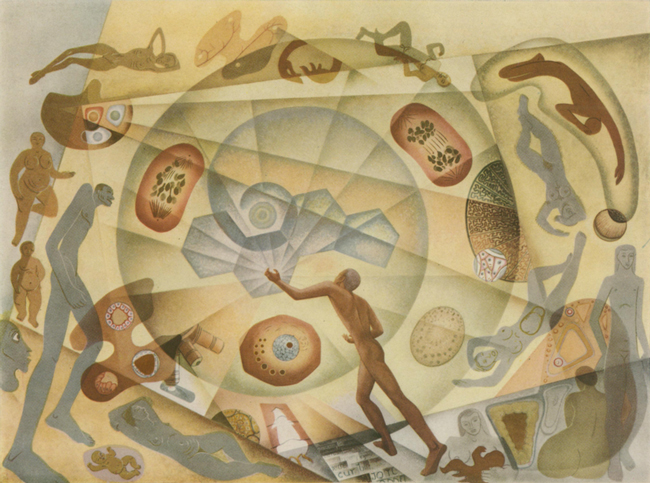
By McGill Reporter Staff
A large avant-garde science mural by the prominent artist Marian Dale Scott is being painstakingly restored in the Strathcona Anatomy and Dentistry Building.
In June 1943, Scott unveiled Endocrinology, a commission by the famed Hungarian-born scientist Hans Selye.
Selye asked Scott to paint on a wall of the second floor reading room in what was then the Histology Department. The result was an unusual representation of what was known about the endocrine system, using a style called biomorphism. A central nude figure represents “the searcher,” marvelling at the interconnected network of the main endocrine glands. Scott’s painting was a dramatic departure from the way science was presented in art at the time. Contrary to other paintings about scientific research, Scott’s painting places an emphasis on the research itself, not the heroic scientist.
Catherine LaRivière is the Rosalind Goodman Arts Research Intern who has been putting together a history of the mural. “Marian Dale Scott was interested in themes outside the norm of the time. When her colleagues were doing landscapes she was doing work on a much larger canvas, more like what was being done in Europe and elsewhere,” says LaRivière. “She was distinctly modern in her approach.”
Marian Dale Scott (née Dale, June 26, 1906 – November 28, 1993) was a prominent member of Montreal society, and one of the generation of women who were determined to attend university or practice as professional artists. She is considered a pioneer of modern art in Canada and was among the first students at the École des beaux-arts de Montréal in 1924. She then went off to London to study at the Slade School of Art. When she got back to Montreal in 1928 she married the legendary poet and McGill law professor F. R. Scott.
Scott’s life is like a précis of the last century. She was active in anti-fascist movements in the 1930s, and the Co-operative Commonwealth Federation, pre-cursor to the New Democratic Party, which her husband co-founded. She taught art to disadvantaged children as part of the Children’s Creative Arts Centre set up by her close friend Norman Bethune in 1936.
As an artist, in the 1940s she turned toward abstraction, seeking inspiration in scientific literature. In the 1950s she campaigned against nuclear weapons, and in the 1960s opposed the Vietnam War. Her art continued to evolve as she continued to explore new techniques using flat plane of color with no reference to realistic subject matter and even painting with her hands.
Scott was a founding member of the short-lived but influential Contemporary Arts Society of Montreal (Société d’art contemporain, 1939–48), and was elected to the Royal Canadian Academy of Arts in 1973. She taught art at St. George’s School, at the Montreal Museum of Fine Arts, and at Macdonald College.
The mural in Strathcona represents the culmination of an intense two-year collaboration between Scott and Dr. Hans Selye (1907–82), considered to be the father of the field of stress research. Scott studied the anatomical, histological and biochemical elements of stress research. She also familiarized herself with the principles of scientific investigation.
The mural measures 12 by 16 feet covering the entire wall and it is being restored by Legris Conservation, with funding from the Lang family.
“We are stabilizing the work,” says David Legris. “Some of the problem is delamination, where the oil paint that was applied to the primer on the wall is actually lifting. The care of a mural is often complex as the aging of the paint, changes in a building’s fabric, and other factors all contribute to conditions that may lead to delamination or other issues.”
Endocrinology was created and painted between 1941 and 1943 and is located in the second-floor conference room in Strathcona Anatomy and Dentistry. The mural is usually viewable upon request, though it is sometimes included in weekly tours of the university’s art collection.
McGill University owns 14 of Marian Dale Scott’s pieces. With the support of Scott’s family, Visual Arts Collection Director Gwendolyn Owens and Intern Catherine LaRivière have embarked on an ambitious research project hoping to advance scholarship on the artist. They hope to produce a book and ideally an exhibition, which will look at Scott’s work in the larger context of avant-garde painting.
